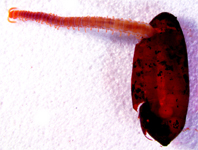Abstract
The previously unknown male of Darditilla araxa is here described based on association with females in copula. We also present a map with its geographical distribution, additional biological notes and a key for known Brazilian males of Darditilla.
References
Baptista-Maria, V.R., Rodrigues, R.R., Damasceno Junior, G., Maria, F.D.S. & Souza, V.C. (2009) Floristic composition of seasonal riparian forests in Mato Grosso do Sul state, Brazil. Acta Botanica Brasilica, 23 (2), 535–548.
https://doi.org/10.1590/S0102-33062009000200025
Bergamaschi, A.C., Cambra, R. & Melo, G.A. (2010) Male description and host record for Lophomutilla corupa Casal, 1968 (Hymenoptera: Mutillidae), with behavioural notes on mating behaviour and host nest attacks. Journal of Natural History, 44 (43–44), 2597–2607.
https://doi.org/10.1080/00222933.2010.499574
Brothers, D.J. (1975) Phylogeny and classification of the aculeate Hymenoptera, with special reference to Mutillidae. University of Kansas Sciences Bulletin, 50, 483–648.
Brothers, D.J. (2006) Familia Mutillidae. In: Fernandez, F. & Sharkey, M.J. (Eds.), Introducción a los Hymenoptera de la Región Neotropical. Sociedad Colombiana de Entomología & Universidad Nacional de Colombia, Bogotá D.C., pp. 577–594.
Brothers, D.J. & Lelej, A.S. (2017) Phylogeny and higher classification of Mutillidae (Hymenoptera) based on morphological reanalyses. Journal of Hymenoptera Research, 60, 1–97.
https://doi.org/10.3897/jhr.60.20091
Cambra, T., Roberto, A., Williams, K.A., Quintero, D., Windsor, D.M., Pickering, J. & Saavedra, D. (2018) Dasymutilla Ashmead (Hymenoptera, Mutillidae) from Panama: new species, sex associations and seasonal flight activity. Insecta Mundi, 0608, 1–17.
Casal, O.H. (1968) Aportaciones para el conocimiento de las Mutillidae de la Republica Argentina. I. – Las hembras del genero Darditilla (Hymenoptera). Revista de la Sociedad Entomológica Argentina, 30 (1–4), 83–96.
Chiradia. C. Dicionário Tupi Guarani. Available from: https://www.dicionariotupiguarani.com.br/dicionario/araxa (accessed 13 January 2018)
Cresson, E.T. (1902) Descriptions of some Mutilla from Brazil. Transactions of the American Entomological Society, 28 (1), 1–82.
Fritz, M.A. & Martínez, A. (1974) Notas sobre Mutillidae, II. (Hymenoptera). Studia Entomologica, 17 (1–4), 313–316.
Harris, R.A. (1979) A glossary of surface sculpturing. Occasional Papers in Entomology Sacramento, (28), 1–31.
Luz, D., Waldren, G.C. & Melo, G.A. (2016) Bees as hosts of mutillid wasps in the Neotropical region (Hymenoptera, Apidae, Mutillidae). Revista Brasileira de Entomologia, 60 (4), 302–307.
https://doi.org/10.1016/j.rbe.2016.06.001
Luz, D.R. & Bartholomay, P.R (2018) Mutillidae in Catálogo Taxonômico da Fauna do Brasil. PNUD. Available from: http://fauna.jbrj.gov.br/fauna/faunadobrasil/13429 (accessed 12 Set 2018)
Luz, D.R. & Williams, K.A. (2014) The first sexual associations in the genus Darditilla Casal, 1965 (Hymenoptera, Mutillidae). ZooKeys, 454, 41–68.
https://doi.org/10.3897/zookeys.454.8558
Löwenberg-Neto, P. (2014) Neotropical region: a shapefile of Morrone’s (2014) biogeographical regionalisation. Zootaxa, 3802 (2), 300.
https://doi.org/10.11646/zootaxa.3802.2.12
Morrone, J.J. (2014) Biogeographical regionalisation of the Neotropical region. Zootaxa, 3782 (1), 1–110.
https://doi.org/10.11646/zootaxa.4239.1.1
Nonveiller, G. (1990) Catalogue of the Mutillidae, Myrmosidae and Bradynobaenidae of the Neotropical Region including Mexico (Insecta, Hymenoptera). Hymenopterorum Catalogus. Nova Editio. Vol. 18. SPB Academic Publishing, Den Haag, 150 pp.
Pilgrim, E.M. & Pitts, J.P. (2006) A molecular method for associating the dimorphic sexes of velvet ants (Hymenoptera: Mutillidae). Journal of Kansas Entomology, 79 (3), 222–230.
https://doi.org/10.2317/0511.09.1
Pilgrim, E.M., Williams, K.A. & Pitts, J.P. (2008) Sex association and synonymy in Southwestern U.S. species of Dasymutilla (Hymenoptera: Mutillidae). The Pan-Pacific Entomologist, 84 (1), 57–68.
https://doi.org/10.3956/2007-13.1
Pitts, J.P., Boud, T.J. & Pilgrim, E.M. (2007) Molecular sex associations of three species of nocturnal velvet ant (Hymenoptera: Mutillidae). Journal of the Kansas Entomological Society, 80 (2), 136–145.
https://doi.org/10.2317/0022-8567(2007)80[136:MSAOTS]2.0.CO;2
Pitts, J.P., Wilson, J.S. & Von Dohlen, C.D. (2010) Evolution of the nocturnal Nearctic Sphaeropthalminae velvet ants (Hymenoptera: Mutillidae) driven by Neogene Orogeny and Pleistocene Glaciation. Molecular Phylogenetics and Evolution, 56 (1), 134–145.
https://doi.org/10.1016/j.ympev.2010.03.033
Quintero, D. & Cambra, R.A. (2001) On the identity of Scaptopoda F. Lynch Arribálzaga, new taxonomic changes and new distribution records for Neotropical Mutillidae (Hymenoptera), with notes on their biology. Transactions of the American Entomological Society, 127 (3), 291–304.
Ribeiro, J.F. & Walter, B.M.T. (2008) As principais fitofisionomias do bioma cerrado In: Sano, S.M., Almeida, S.P. & Ribeiro, J.F (Eds.), Cerrado: Ecologia e flora. Embrapa Informação Tecnológica, Brasília, pp. 421–1279.
Wilson, J.S. & Pitts, J.P. (2010) Pleistocene diversification of the Odontophotopsis unicornis species-group (Hymenoptera: Mutillidae). Annals of the Entomological Society of America, 103 (4), 555–565.
https://doi.org/10.1603/AN09177
Wilson, J.S. & Pitts, J.P. (2011) Pleistocene connection between the Nearctic Mediterranean and desert regions in the Sphaeropthalma unicolor species-complex (Hymenoptera: Mutillidae). Insect Conservation and Diversity, 4 (3), 222–234.
https://doi.org/10.1111/j.1752-4598.2010.00124.x
Wilson, J.S. & Pitts, J.P. (2012) Identifying Pleistocene refugia in North American cold deserts using phylogeographic analyses and ecological niche modeling. Diversity and Distributions, 18 (11), 1139–1152.
https://doi.org/10.1111/j.1472-4642.2012.00902.x
Wilson, J.S., Clark, S.L., Williams, K.A. & Pitts, J.P. (2012) Historical biogeography of the arid-adapted velvet ant Sphaeropthalma arota (Hymenoptera: Mutillidae) reveals cryptic species. Journal of Biogeography, 39 (2), 336–352.
https://doi.org/10.1111/j.1365-2699.2011.02580.x
Zanella, F.C.V. (2011) Evolução da biota da diagonal de formações abertas secas da América do Sul. In: Carvalho, C.J. & Almeida, E.B. (Eds.), Biogeografia da América do Sul: padrões e processos. Editora Roca, São Paulo, pp. 198–220.

